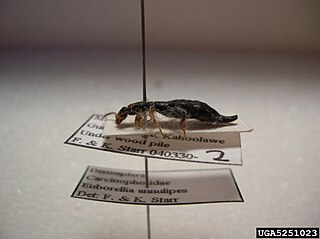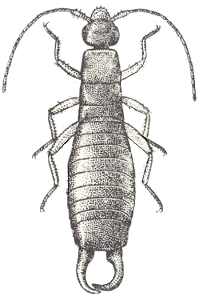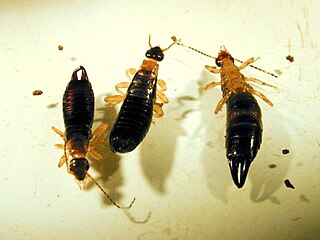
Earwigs make up the insect order Dermaptera. With about 2,000 species in 12 families, they are one of the smaller insect orders. Earwigs have characteristic cerci, a pair of forcep-like pincers on their abdomen, and membranous wings folded underneath short, rarely used forewings, hence the scientific order name, "skin wings". Some groups are tiny parasites on mammals and lack the typical pincers. Earwigs are found on all continents except Antarctica.

Pygidicranidae is a family of earwigs in the suborder Neodermaptera. The family currently contains twelve subfamilies and twenty six genera. Eight of the subfamilies are monotypic, each containing a single genus. Of the subfamilies, both Astreptolabidinae and Burmapygiinae are extinct and known solely from fossils found in Burmese amber. Similarly Archaeosoma, Gallinympha, and Geosoma, which have not been placed into any of the subfamilies, are also known only from fossils. Living members of the family are found in Australia, South Africa, North America, and Asia. The monotypic genus Anataelia, described by Ignacio Bolivar in 1899, is found only on the Canary Islands. As with all members of Neodermaptera, pygidicranids do not have any ocelli. The typical pygidicranid bodyplan includes a small, flattened-looking body, which has a dense covering of bristly hairs (setae). The pair of cerci at the end of the abdomen are symmetrical in structure. The head is broad, with the fourth, fifth and sixth antenna segments (antennomeres) that are not transverse. In general Pygidicranids also have equally sized ventral cervical sclerites, and in having the rearmost sclerite separated from, or only touching the center of the prosternum. Cannibalism of young has been observed in at least one species in the family, Challia hongkongensis, in which an adult female was found eating a still-living nymph of the same species. The same species in a different area has been observed possibly eating fruits or seeds, making the species an omnivore.

Forficulidae is a family of earwigs in the order Dermaptera. There are more than 70 genera and 490 described species in Forficulidae.

Anisolabidinae, alternatively known as Carcinophorinae, Gonolabiinae, or Placolabidinae, is a subfamily of earwigs containing 17 genera.
Aborolabis is a genus of earwigs in the subfamily Anisolabidinae. It was cited by Srivastava in Part 2 of Fauna of India.

Anisolabis is a genus of mostly Asian earwigs in the subfamily Anisolabidinae. It was cited by Srivastava in Part 2 of Fauna of India. The name Anisolabis stems from the asymmetry of the male cerci; the right cercus being more acute than the left.
Antisolabis is a genus of earwigs, the sole member of the subfamily Antisolabiinae. It was cited by Srivastava in Part 2 of Fauna of India. It was also cited at an earlier date by Steinmann in his publication, The Animal Kingdom in 1986, 1989, 1990, and 1993.
Epilandex is a genus of earwigs in the subfamily Anisolabidinae. It was cited by Srivastava in Part 2 of Fauna of India.

Euborellia is a genus of earwigs in the subfamily Anisolabidinae. This genus, which has a world-wide distribution, was erected by Malcolm Burr in 1909 and was cited by Srivastava in Part 2 of Fauna of India.

Gonolabis is a genus of earwigs in the subfamily Anisolabidinae. It was cited by Srivastava in Part 2 of Fauna of India.
Placolabis is a genus of earwigs in the subfamily Anisolabidinae. It was cited by Srivastava in Part 2 of Fauna of India.
Platylabia is a genus of earwigs, the sole member of the subfamily Platylabiinae. It was cited by Srivastava in Part 2 of Fauna of India. It was also cited at an earlier date by Steinmann in his publication, The Animal Kingdom in 1986, 1989, 1990, and 1993, and by Chen & Ma in Fauna Sinica in 2004.

Titanolabis is a genus of earwigs in the subfamily Titanolabidinae. Among its species is the Australian T. colossea, which at about 5 cm (2.0 in) long is the largest certainly living species of earwig.
Sankuchemys is an extinct genus of side-necked turtle whose fossils had been found in the Intertrappean Formation of India during the late Cretaceous period. It was first named by Eugene S. Gaffney, Ashok Sahni, Herman Schleich, Swarn Deep Singh, and Rahul Srivastava in 2003, and contains the species Sankuchemys sethnai.

Spongiphoridae is a family of earwigs in the suborder Neodermaptera. There are more than 40 genera and 510 described species in Spongiphoridae.
Decemtestis is a genus of trematodes in the family Opecoelidae. It has been synonymised with Allodecemtestis Hafeezullah, 1970.
Irdex is a genus of earwigs belonging to the subfamily Spongiphorinae.
Haplodiplatys is a genus of Asian earwigs erected by Walter Douglas Hincks in 1955. It is the only member of the monotypic family Haplodiplatyidae, with many species originally placed in the genus Diplatys; a key to them was prepared by Alan Brindle.
Liparura is a genus of earwigs within the family Forficulidae.








